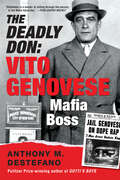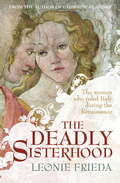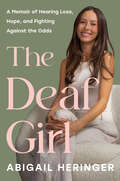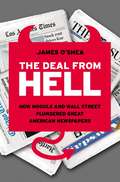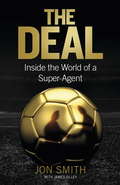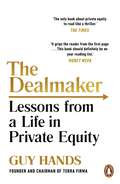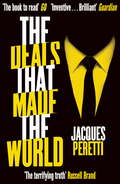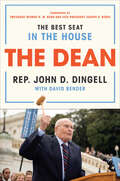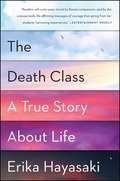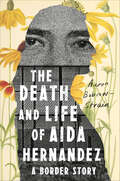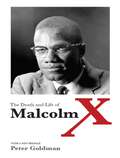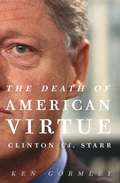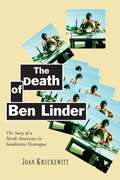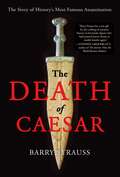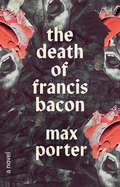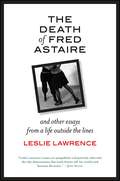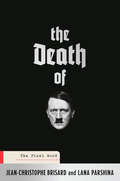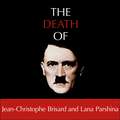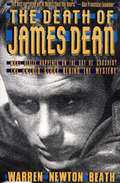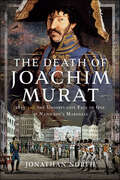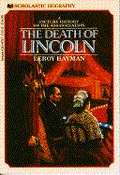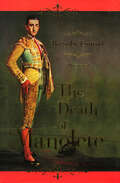- Table View
- List View
The Deadly Don: Vito Genovese, Mafia Boss
by Anthony M. DeStefanoFrom enforcer to godfather, Vito Genovese rose through the ranks of La Cosa Nostra to head of one of the wealthiest and most dangerous crime families in American history. Vito Genoveseran rackets as a member of Giuseppe &“Joe the Boss&” Masseria&’s gang in New York City before joining forces with Lucky Luciano, Frank Costello, Meyer Lansky, and Bugsy Siegel as bootleggers during Prohibition. As a soldier in the Castellammarese War, he helped orchestrate Masseria&’s death on behalf of Brooklyn crime lord Salvatore Maranzano, consolidating his position and power before ensuring Maranzano, too, was knocked off. For the next three decades, Vito Genovese—shrewd, merciless, and utterly savage—killed countless gangsters in his bid to become the capo di tutti i capi—boss of bosses—in the American Mafia. Genovese would betray some of the mafia&’s most notorious bosses, including Albert Anastasia and Frank Costello, to eventually seize control of the Luciano crime family, one that still bears his name today. In The Deadly Don, Pulitzer Prize-winning journalist Anthony M. DeStefano presents the rise and fall of Vito Genovese in this first comprehensive biography of the legendary mafioso—from his childhood in Naples, Italy, and the beginnings of his bullet-ridden criminal career on lower Manhattan&’s mean streets, through his self-exile in the mid-1930s back to his homeland where he ran a black market operation under the fascist regime of Benito Mussolini, and his return to New York where Genovese made a fortune as the head of an illegal narcotics empire. DeStefano reveals the important and terrifying role Genovese played in the creation of the Mafia, detailing his bloody and ruthless lifetime of crime that would put him behind bars for his last fifteen years—and securing his infamous place in the history of organized crime.
The Deadly Sisterhood: A story of Women, Power and Intrigue in the Italian Renaissance (P. S. Ser.)
by Leonie FriedaThe women who wielded the real power behind the throne in Renaissance Italy, from a bestselling historian.This book is one of drama on a grand scale, a Renaissance epic, as Christendom emerged from the shadows of the calamitous 14th century. The sweeping tale involves inspired and corrupt monarchs, the finest thinkers, the most brilliant artists and the greatest beauties in Christendom. Here are the stories of its most remarkable women, who are all joined by birth, marriage and friendship and who ruled for a time in place of their men-folk: Lucrezia Turnabuoni (Queen Mother of Florence, the power behind the Medici throne), Clarice Orsini (Roman princess, feudal wife), Beatrice d'Este (Golden Girl of the Renaissance), Caterina Sforza (Lioness of the Romagna), Isabella d'Este (the Acquisitive Marchesa), Giulia Farnese ('la bella', the family asset), Isabella d'Aragona (the Weeping Duchess) and Lucrezia Borgia (the Virtuous Fury). The men play a secondary role in this grand saga; whenever possible the action is seen through the eyes of our heroines.These eight women experienced great riches, power and the warm smile of fortune, but they also knew banishment, poverty, the death of a husband or the loss of one or more of their children. As each of the chosen heroines comes to the fore in her turn, she is handed the baton by her 'sister', and Leonie Frieda recounts the role each woman played in the hundred-year drama that is THE DEADLY SISTERHOOD.
The Deadly Sisterhood: A story of Women, Power and Intrigue in the Italian Renaissance (P. S. Ser.)
by Leonie FriedaThe women who wielded the real power behind the throne in Renaissance Italy, from a bestselling historian.This book is one of drama on a grand scale, a Renaissance epic, as Christendom emerged from the shadows of the calamitous 14th century. The sweeping tale involves inspired and corrupt monarchs, the finest thinkers, the most brilliant artists and the greatest beauties in Christendom. Here are the stories of its most remarkable women, who are all joined by birth, marriage and friendship and who ruled for a time in place of their men-folk: Lucrezia Turnabuoni (Queen Mother of Florence, the power behind the Medici throne), Clarice Orsini (Roman princess, feudal wife), Beatrice d'Este (Golden Girl of the Renaissance), Caterina Sforza (Lioness of the Romagna), Isabella d'Este (the Acquisitive Marchesa), Giulia Farnese ('la bella', the family asset), Isabella d'Aragona (the Weeping Duchess) and Lucrezia Borgia (the Virtuous Fury). The men play a secondary role in this grand saga; whenever possible the action is seen through the eyes of our heroines.These eight women experienced great riches, power and the warm smile of fortune, but they also knew banishment, poverty, the death of a husband or the loss of one or more of their children. As each of the chosen heroines comes to the fore in her turn, she is handed the baton by her 'sister', and Leonie Frieda recounts the role each woman played in the hundred-year drama that is THE DEADLY SISTERHOOD.
The Deaf Girl: A Memoir of Hearing Loss, Hope, and Fighting Against the Odds
by Abigail HeringerAn inspiring story of hearing loss and hope from The Bachelor's first deaf contestantAbigail Heringer made her television debut as an instant fan-favorite on season 25 of The Bachelor. Stepping out of the limousine, she approached her bachelor with a playful declaration: she would be staring at his lips all night for two compelling reasons—her profound deafness since birth and because he had some nice lips!But Abigail's journey wasn't always marked by such confidence. Growing up deaf and introverted, she dreaded being the center of attention, fearing her disability would burden those around her. Among her hearing peers, she felt like an outsider, simply labeled as "the deaf girl." And after receiving a cochlear implant at the age of two, she subsequently struggled to find her place in the Deaf community too. Caught in between two worlds and grappling to define her identity as a deaf woman, Abigail felt like she belonged in neither.Supported by her family, particularly her deaf older sister Rachel, Abigail has come to understand that while being deaf is part of her identity, it doesn't define her. Throughout her journey, marked by challenges and adversity, Abigail has grown into her own strongest advocate, discovering a new voice that is confident, fearless, and empowered—a voice that enables her to proudly reclaim the title of "the deaf girl" she once resisted and rewrite it as a testament to her resilience and strength.Hopeful, vulnerable, and uplifting, The Deaf Girl shares Abigail's journey of navigating life with a profound hearing loss and her transformation from merely accepting her disability to embracing it wholeheartedly. This memoir serves as an inspiring reminder for anyone who has ever felt like an outsider or struggled to embrace their differences, showcasing that every voice is worthy of being heard.
The Deal from Hell
by James O'SheaIn 2000, after the Tribune Company acquired Times Mirror Corporation, it comprised the most powerful collection of newspapers in the world. How then did Tribune nosedive into bankruptcy and public scandal? <P><P>In The Deal From Hell, veteran Tribune and Los Angeles Times editor James O'Shea takes us behind the scenes of the decisions that led to disaster in boardrooms and newsrooms from coast to coast, based on access to key players, court testimony, and sworn depositions. The Deal From Hell is a riveting narrative that chronicles how news industry executives and editors--convinced they were acting in the best interests of their publications--made a series of flawed decisions that endangered journalistic credibility and drove the newspapers, already confronting a perfect storm of political, technological, economic, and social turmoil, to the brink of extinction.
The Deal: Inside the World of a Super-Agent
by Jon Smith'Excellent . . . an in-depth excavation of the murky and mysterious world of football business. Smith's candid and often shocking book reveals the true workings of football business that take into account things few of us even could even imagine . . . The Deal answers some of those questions and leaves you wanting more. It is an educational tool that most fans could do with researching' Joe Short, ExpressFootball analysis has grown at the same exponential rate as the sport's popularity and yet one of its most intrinsic elements remains tantalisingly opaque: the role of 'agent'. The Deal is a unique and fascinating perspective into the business of sports management through the eyes of 'Mr Football', 'super-agent', Jon Smith. 800,000 watch their professional football team play each week and TV pulls in audiences of around 600 million. Despite these phenomenal figures, the complex money-making scene behind sport is one of its biggest mysteries. The Deal will be an unprecedented insight into this world, showing what goes on as players and big money change hands. The Deal is also the story of one of the shrewdest and most successful businessmen of our time. Documented through Jon's personal rollercoaster of high-flying success to near bankruptcy, the book's over-arching narrative will offer an inspiring personal journey as well as insider knowledge of brokering deals at a high level and under extreme pressure. The Deal will appeal strongly to buyers of business books as well as a significant number of sports fans interested to know what goes on in the back room of their favourite sport.
The Dealmaker: Lessons from a Life in Private Equity
by Guy HandsAn inside account of the multi-billion pound world of private equity and a masterclass on the art of deal-making.The Dealmaker is a frank and honest account of how a severely dyslexic child who struggled at school went on to graduate from Oxford and become a serial entrepreneur. It describes Guy Hand's career in private equity, first at Nomura and then as head of his own company, Terra Firma. It looks in detail at the huge deals that Terra Firma has done over the years, involving everything from cinema chains and pubs to waste management, aircraft leasing and green energy. And it offers a brutally honest appraisal of the deal that almost bankrupted him - the acquisition of multinational music recording and publishing company EMI in 2007, just as a global financial crash loomed on the horizon. Above all, he gives the reader a real sense of what it's like inside the secretive world of private equity, describing in frank detail the pressures and rewards involved. Insightful and page-turning, The Dealmaker will prove inspirational and essential reading for all those who want to understand how huge business negotiations are done, and what makes one of private equity's biggest players tick.
The Deals that Made the World
by Jacques Peretti'The book to read' GQ'A revelatory book' John Lewis-StempelWhile the laws that guide our lives are written by the politicians we elect, much of the world around us - from the food we eat to the products we buy to the medications we take - is shaped by private negotiations and business deals few of us know about.For twenty years, Peretti has interviewed the people behind the decisions that have altered our world, from CEOs of multinational corporations to politicians, economists, and scientists. In The Deals that Made the World, Peretti draws on his vast knowledge to reveal a host of fascinating and startling connections, from how Wall Street's actions on food commodities helped spark the Arab Spring to the link between the AIDS epidemic in 1980s San Francisco and the subprime mortgage crisis of 2008. He proves a sure guide, combining both eye-opening on-the-ground reporting and a narrative flair that makes esoteric financial and business concepts clear and understandable.Like Steven Levitt, Nassim Nicholas Taleb, Brad Stone, Michael Lewis, and Malcolm Gladwell, Peretti takes the ordinary and turns it inside out to give us a compelling new perspective on our lives and our world.
The Dean: The Best Seat in the House
by David Bender John David DingellA candid memoir of the past eighty years in American politics, as told by the longest-serving congressman in historyCongressman John D. Dingell first came to Washington, DC, in 1933 at the age of six, when his father was elected to the Congress, and became a House page boy at eleven. Dingell has devoted his entire life to public service and has witnessed and helped shape most of the important political events that profoundly changed America over the last nine decades. Rife with wisdom born of unparalleled experience and filled with the caustic candor that has made him a living legend on “the Twitter Machine,” The Dean is the inside story of the greatest legislative achievements in modern American history and of the tough fights that made them possible. Here Dingell looks back at his life at the center of American government and vividly describes the political currents that swirled through Congress and the nation. At the age of fifteen, Dingell was in the House Chamber on December 8, 1941, and personally heard President Roosevelt declare it “a date which will live in infamy.” Almost a quarter century later, he presided over the House when Medicare was passed and led the health care reform effort in the House of Representatives from his first term in 1955 through the passage of the Affordable Care Act in 2010, when President Obama invited Dingell to sit at the table when the bill was signed into law. Congressman Dingell worked closely alongside some of the most legendary names in American politics, including Presidents John F. Kennedy, Lyndon Johnson, and Barack Obama; Vice Presidents Hubert Humphrey and Joseph Biden; Senator Ted Kennedy; and House Speakers Sam Rayburn and John McCormack. And though he is a lifelong, proud Democrat, Dingell built lasting bipartisan friendships with Republican leaders such as Presidents Gerald Ford, George H. W. Bush, and George W. Bush, Secretary of State James Baker, and Senator Alan Simpson.And in a scathingly powerful afterword, Dingell addresses our nation’s future in the wake of an unprecedented attack on all our democratic institutions. He presents a persuasive defense of government, reminding us how it once worked honorably and well across the aisle, and offers hope for how it can do so again. By sharing his personal story as a descendant of immigrants, Dingell also reminds us of this country’s founding promise to remain a beacon of liberty to the entire world. The Dean is essential reading for all who love this country as deeply as John D. Dingell does.
The Death Class: A True Story About Life
by Erika HayasakiThe poignant, “powerful” (The Boston Globe) look at how to appreciate life from an extraordinary professor who teaches about death: “Poetic passages and assorted revelations you’ll likely not forget” (Chicago Tribune).Why does a college course on death have a three-year waiting list? When nurse Norma Bowe decided to teach a course on death at a college in New Jersey, she never expected it to be popular. But year after year students crowd into her classroom, and the reason is clear: Norma’s “death class” is really about how to make the most of what poet Mary Oliver famously called our “one wild and precious life.” Under the guise of discussions about last wills and last breaths and visits to cemeteries and crematoriums, Norma teaches her students to find grace in one another. In The Death Class, award-winning journalist Erika Hayasaki followed Norma for more than four years, showing how she steers four extraordinary students from their tormented families and neighborhoods toward happiness: she rescues one young woman from her suicidal mother, helps a young man manage his schizophrenic brother, and inspires another to leave his gang life behind. Through this unorthodox class on death, Norma helps kids who are barely hanging on to understand not only the value of their own lives, but also the secret of fulfillment: to throw yourself into helping others. Hayasaki’s expert reporting and literary prose bring Norma’s wisdom out of the classroom, transforming it into an inspiring lesson for all. In the end, Norma’s very own life—and how she lives it—is the lecture that sticks. “Readers will come away struck by Bowe’s compassion—and by the unexpectedly life-affirming messages of courage that spring from her students’ harrowing experiences” (Entertainment Weekly).
The Death and Afterlife of the North American Martyrs
by Emma AndersonIn the 1640s--a decade of epidemic and warfare across colonial North America--eight Jesuit missionaries met their deaths at the hands of native antagonists. With their collective canonization in 1930, these men, known to the devout as the North American martyrs, would become the continents first official Catholic saints. In "The Death and Afterlife of the North American Martyrs," Emma Anderson untangles the complexities of these seminal acts of violence and their ever-changing legacy across the centuries. While exploring how Jesuit missionaries perceived their terrifying final hours, the work also seeks to comprehend the motivations of the those who confronted them from the other side of the axe, musket, or caldron of boiling water, and to illuminate the experiences of those native Catholics who, though they died alongside their missionary mentors, have yet to receive comparable recognition as martyrs by the Catholic Church. In tracing the creation and evolution of the cult of the martyrs across the centuries, Anderson reveals the ways in which both believers and detractors have honored and preserved the memory of the martyrs in this "afterlife," and how their powerful story has been continually reinterpreted in the collective imagination over the centuries. As rival shrines rose to honor the martyrs on either side of the U. S. -Canadian border, these figures would both unite and deeply divide natives and non-natives, francophones and anglophones, Protestants and Catholics, Canadians and Americans, forging a legacy as controversial as it has been enduring.
The Death and Life of Aida Hernandez: A Border Story
by Aaron Bobrow-StrainOne of Esquire's 50 Best Biographies of All TimeWinner of the 2020 Pacific Northwest Book Award | Winner of the 2020 Washington State Book Award | Named a 2019 Southwest Book of the Year | Shortlisted for the 2019 Brooklyn Public Library Literary PrizeWhat happens when an undocumented teen mother takes on the U.S. immigration system?When Aida Hernandez was born in 1987 in Agua Prieta, Mexico, the nearby U.S. border was little more than a worn-down fence. Eight years later, Aida’s mother took her and her siblings to live in Douglas, Arizona. By then, the border had become one of the most heavily policed sites in America.Undocumented, Aida fought to make her way. She learned English, watched Friends, and, after having a baby at sixteen, dreamed of teaching dance and moving with her son to New York City. But life had other plans. Following a misstep that led to her deportation, Aida found herself in a Mexican city marked by violence, in a country that was not hers. To get back to the United States and reunite with her son, she embarked on a harrowing journey. The daughter of a rebel hero from the mountains of Chihuahua, Aida has a genius for survival—but returning to the United States was just the beginning of her quest.Taking us into detention centers, immigration courts, and the inner lives of Aida and other daring characters, The Death and Life of Aida Hernandez reveals the human consequences of militarizing what was once a more forgiving border. With emotional force and narrative suspense, Aaron Bobrow-Strain brings us into the heart of a violently unequal America. He also shows us that the heroes of our current immigration wars are less likely to be perfect paragons of virtue than complex, flawed human beings who deserve justice and empathy all the same.
The Death and Life of Malcolm X
by Peter GoldmanThe Death and Life of Malcolm X provides a dramatic portrait of one of the most important black leaders of the twentieth century. Focusing on Malcolm X's rise to prominence and the final year of his life, the book details his rift with the Nation of Islam and its leader, Elijah Muhammad, leading to death threats and eventually assassination at the hands of a death squad. In a new preface for this edition, Peter Goldman reflects on the forty years since the book's first publication and considers new information based on FBI surveillance that has since come to light.
The Death of American Virtue: Clinton vs. Starr
by Ken GormleyTen years after one of the most polarizing political scandals in American history, author Ken Gormley offers an insightful, balanced, and revealing analysis of the events leading up to the impeachment trial of President William Jefferson Clinton. From Ken Starr's initial Whitewater investigation through the Paula Jones sexual harassment suit to the Monica Lewinsky affair, The Death of American Virtue is a gripping chronicle of an ever-escalating political feeding frenzy.In exclusive interviews, Bill Clinton, Ken Starr, Monica Lewinsky, Paula Jones, Susan McDougal, and many more key players offer candid reflections on that period. Drawing on never-before-released records and documents--including the Justice Department's internal investigation into Starr, new details concerning the death of Vince Foster, and evidence from lawyers on both sides--Gormley sheds new light on a dark and divisive chapter, the aftereffects of which are still being felt in today's political climate.From the Hardcover edition.
The Death of Ben Linder: The Story of a North American in Sandinista Nicaragua
by Joan KruckewittIn 1987, the death of Ben Linder, the first American killed by President Reagan's "freedom fighters" -- the U.S.-backed Nicaraguan Contras -- ignited a firestorm of protest and debate. In this landmark first biography of Linder, investigative journalist Joan Kruckewitt tells his story. In the summer of 1983, a 23-year-old American named Ben Linder arrived in Managua with a unicycle and a newly earned degree in engineering. In 1986, Linder moved from Managua to El Cuá, a village in the Nicaraguan war zone, where he helped form a team to build a hydroplant to bring electricity to the town. He was ambushed and killed by the Contras the following year while surveying a stream for a possible hydroplant. In 1993, Kruckewitt traveled to the Nicaraguan mountains to investigate Linder's death. In July 1995. she finally located and interviewed one of the men who killed Ben Linder, a story that became the basis for a New Yorker feature on Linder's death. Linder's story is a portrait of one idealist who died for his beliefs, as well as a picture of a failed foreign policy, vividly exposing the true dimensions of a war that forever marked the lives of both Nicaraguans and Americans.
The Death of Caesar: The Story of History’s Most Famous Assassination
by Barry StraussThe exciting, dramatic story of one of history's most famous events--the death of Julius Caesar--now placed in full context of Rome's civil wars by eminent historian Barry Strauss.Thanks to William Shakespeare, the death of Julius Caesar is the most famous assassination in history. But what actually happened on March 15, 44 BC is even more gripping than Shakespeare's play. In this thrilling new book, Barry Strauss tells the real story. Shakespeare shows Caesar's assassination to be an amateur and idealistic affair. The real killing, however, was a carefully planned paramilitary operation, a generals' plot, put together by Caesar's disaffected officers and designed with precision. There were even gladiators on hand to protect the assassins from vengeance by Caesar's friends. Brutus and Cassius were indeed key players, as Shakespeare has it, but they had the help of a third man--Decimus. He was the mole in Caesar's entourage, one of Caesar's leading generals, and a lifelong friend. It was he, not Brutus, who truly betrayed Caesar. Caesar's assassins saw him as a military dictator who wanted to be king. He threatened a permanent change in the Roman way of life and in the power of senators. The assassins rallied support among the common people, but they underestimated Caesar's soldiers, who flooded Rome. The assassins were vanquished; their beloved Republic became the Roman Empire. An original, fresh perspective on an event that seems well known, Barry Strauss's book sheds new light on this fascinating, pivotal moment in world history.
The Death of Elizabeth I
by Catherine LoomisThe death of Queen Elizabeth I in 1603 was greeted by an outpouring of official proclamations, gossip-filled letters, tense diary entries, diplomatic dispatches, and somber sermons. English poets wrote hundreds of elegies to Elizabeth, and playwrights began bringing her onto the stage. This book uses these historical and literary sources, including a maid of honor's eyewitness account of the explosion of the Queen's corpse, to provide a detailed history of Elizabeth's final illness and death, and to show Elizabeth's subjects - peers and poets, bishops and beggars, women and men - responding to their loss by remembering and reconstructing their Queen. "
The Death of Francis Bacon: A Novel
by Max PorterMadrid. Unfinished. Man dying.A great painter lies on his deathbed, synapses firing, writhing and reveling in pleasure and pain as a lifetime of chaotic and grotesque sense memories wash over and envelop him.In this bold and brilliant short work of experimental fiction by the author of Grief Is the Thing with Feathers and Lanny, Max Porter inhabits Francis Bacon in his final moments, translating into seven extraordinary written pictures the explosive final workings of the artist's mind. Writing as painting rather than about painting, Porter lets the images he conjures speak for themselves as they take their revenge on the subject who wielded them in life. The result is more than a biography: The Death of Francis Bacon is a physical, emotional, historical, sexual, and political bombardment--the measure of a man creative and compromised, erotic and masochistic, inexplicable and inspired.
The Death of Fred Astaire: And Other Essays from a Life outside the Lines (Excelsior Editions)
by Leslie LawrenceFinalist for the 2016 Foreword INDIES Book of the Year Award in the Autobiography & Memoir categoryAs a child of the sixties, Leslie Lawrence knew she didn't want to duplicate her parents' lives, yet she never imagined she'd stray so far outside the lines of their—and her own—expectations.The Death of Fred Astaire opens with the story, both wrenching and funny, of how Lawrence says her goodbyes to the iconic images she's held since her youth; she then proceeds to bear a child and raise him with her lesbian partner. Some essays in this debut collection reflect on legacies Lawrence inherited from her Jewish family and culture. In others, she searches gamely for a rich, authentic life—a voice, a vocation, a community, even a "god" she can call her own.Always a seeker, an adventurer resisting fear, Lawrence, a city girl, creates a summer home in the back woods of the "Live Free or Die" state. She attempts the flying trapeze and takes part in a cross-dressing workshop. Traveling alone to Morocco, she assists a veterinarian tending to an ailing donkey. Teaching in a vocational high school in Boston, she questions her methods and assumptions about race and class. With rare honesty, she confronts the complexities of motherhood, of caring for her ill partner, and of widowhood. In "Wonderlust," the collection's most ambitious piece, she explores the role of beauty and creativity in our spiritual lives, revealing how lifelong learning in dance, music, and the visual arts can make us all more alive even as we age.Ranging widely in length, subject, and style, these personal essays place Lawrence among today's most vital writers of creative nonfiction. Her warmth and wisdom, her distinctive blend of humor and pathos, her reverence for what sustains us—food and family, community and beauty—all make this a book you'll want to share with those you love.
The Death of Hitler: The Final Word
by Jean-Christophe Brisard Lana ParshinaOn April 30, 1945, Hitler committed suicide in his bunker as the Red Army closed in on Berlin. Within four days the Soviets had recovered his body. But the truth about what the Russian secret services found was hidden from history, when, three months later, Stalin officially declared to Truman and Churchill that Hitler was still alive and had escaped abroad. Reckless rumors about what really happened to Hitler began to spread like wildfire and, even today, they have not been put to rest. Until now.In 2017, after two years of painstaking negotiations with the Russian authorities, award-winning investigative journalists Jean-Christophe Brisard and Lana Parshina gained access to confidential Soviet files that finally revealed the truth behind the incredible hunt for Hitler's body.Their investigation includes new eyewitness accounts of Hitler's final days, exclusive photographic evidence and interrogation records, and exhaustive research into the power struggle that ensued between Soviet, British, and American intelligence services. And for the first time since the end of World War II, official, cutting-edge forensic tests have been completed on the human remains recovered from the bunker graves--a piece of skull with traces of a lethal bullet, a fragment of bone, and teeth.In The Death of Hitler--written as thrillingly as any spy novel--Brisard and Parshina debunk all previous conspiracy theories about the death of the Führer. With breathtaking precision and immediacy they penetrate one of the most powerful and controversial secret services to take readers inside Hitler's bunker in its last hours--and solve the most notorious cold case in history.
The Death of Hitler: The Final Word on the Ultimate Cold Case: The Search for Hitler's Body
by Jean-Christophe Brisard Lana ParshinaA dramatic and revelatory new account of the final days in Hitler's bunker, based on new access to previously unseen Soviet archives, previously unseen materials, and cutting edge forensics.After two years of nonstop negotiations with the Russian authorities, Jean-Christophe Brisard and Lana Parshina were granted access to secret files detailing the Soviets' incredible hunt to recover Hitler's body: the layout of the bunker, plans for escaping, eyewitness accounts of the Führer's final days, and human remains-a bit of skull with traces of the lethal bullet and a fragment of jaw bone. For the first time, the skull, teeth and other elements were analysed by a medical examiner with cutting edge forensics equipment. The authors use these never before seen documents and research to reconstruct the events in fascinating new detail.(P)2018 Hodder & Stoughton Limited
The Death of James Dean
by Warren Newton BeathWith extensive research, this account of the Hollywood star and his legion of fans offers “the best narrative yet of Dean’s final ten hours” (San Francisco Examiner). Just before sunset on September 20, 1955, James Byron Dean’s Porsche 550 Spyder collided with Donald Gene Turnupseed’s Ford Tudor on California Highway 46. At age twenty-four, America’s newest screen idol was dead. But what really happened? Drawing on original documents, including the coroner’s inquest and other previously unpublished material, author Warren Newton Beath provides a painstakingly accurate reconstruction of Dean’s final hours and tragic death. In addition, Beath explores Dean’s life and his enduring status as a cultural icon, including Elvis Presley’s worship of him; Hitchcock’s use of Highway 46 in the famous crop-dusting scene in North by Northwest; death threats against Giant director George Stevens if he dared excise a single frame of Deans’ final performance; and many more fascinating facts about the enigmatic screen legend. Beath’s definitive account concludes with a memorable portrait of the James Dean cult, a strangely moving record of his posthumous life in the hearts of his adoring fans.
The Death of Joachim Murat: 1815 and the Unfortunate Fate of One of Napoleon's Marshals
by Jonathan NorthThe only English-language book on the fall and death of Joachim Murat and the final act in the drama of the Napoleonic Wars. Joachim Murat, son of an innkeeper, had won his spurs as Napoleon’s finest cavalry general and then won his throne when, in 1808, Napoleon appointed him king of Naples. He loyally ran this strategic Italian kingdom with his wife, Napoleon’s sister Caroline, until, in 1814, with Napoleon beaten and in retreat towards ruin and exile, the royal couple chose to betray their imperial relation and dramatically switched sides. This notorious betrayal won them temporary respite, but just a year later Murat engineered his own dramatic fall. A series of blunders took the cavalier king from thinking he had secured his dynasty to fleeing his kingdom. His native France did not welcome him, initially because Napoleon had not forgiven him, then, after Napoleon’s fall following Waterloo, because the restored Bourbons were offering a reward for Murat’s head. Fleeing again, fate brought him to Corsica where, welcomed at last, Murat turned to plotting the reversal in his fortunes he so felt he deserved. Murat soon resolved to bet everything on a hare-brained plan to return to Naples as a conquering hero and king. His aim was to take a small band of followers, land near his capital, organise regime change and reclaim his throne. In September 1815, he set off and what happened next forms the core of this part-tragic, part-ridiculous story and a lesson in how not to stage a coup. Just five days after landing in Calabria, King Joachim was hauled before a firing squad and executed. There is a fine line in history between a fool and a hero. Had Murat succeeded then he would be lauded as daringly heroic but, alas, he failed, and his final adventure has been consigned to oblivion. This is unfortunate as the fall of Joachim Murat is the final act of the Napoleonic Wars in Europe as well as being a dramatic story in its own right. Based on research in the archives of Paris and Naples, Jonathan North’s book aims to throw light on the fate of the mightily fallen Murat and restore some history to a tale that, until now, lay smothered under two centuries of fable and neglect.
The Death of Lincoln: A Picture History of the Assassination
by Leroy HaymanAn account of the events leading to the assassination of Lincoln as well as the arrest, trial and punishment of the accused.
The Death of Manolete
by Barnaby ConradOn Thursday, August 28, 1947, a 30-year-old millionaire named Manuel Laureano Rodriguez— Manolete— and a Miura bull named Islero killed each other. In The Death of Manolete, Barnaby Conrad recounts the extraordinary life and demise of this young bullfighter, from the childhood that made the Spanish boy and the sacrifice that made the man to the girl who brought him love and the acclaim that brought him incredible success. A symbol of Latin pride, valor, and chivalry, Manolete fired the Latin imagination as no one had done since El Cid. But the crowds owned him, and on one fateful afternoon in the town of Linares, he did their bidding— and an untimely death snuffed out the brightest flame in Spain. Featuring more than 250 images, this photo-narrative provides a stirring farewell to a beloved bullfighter.
